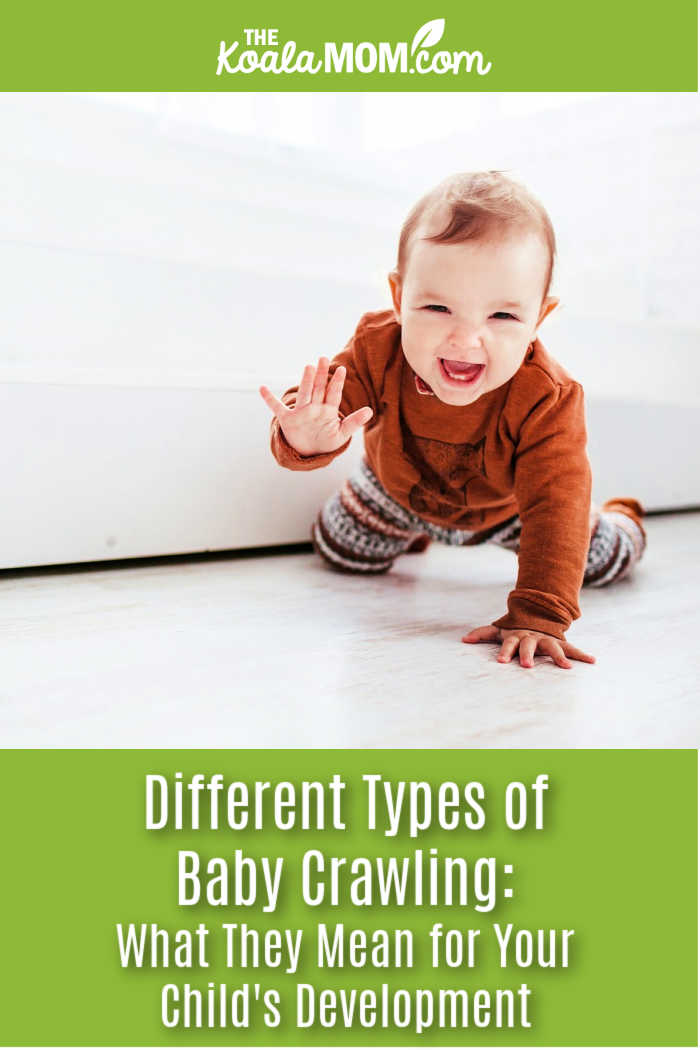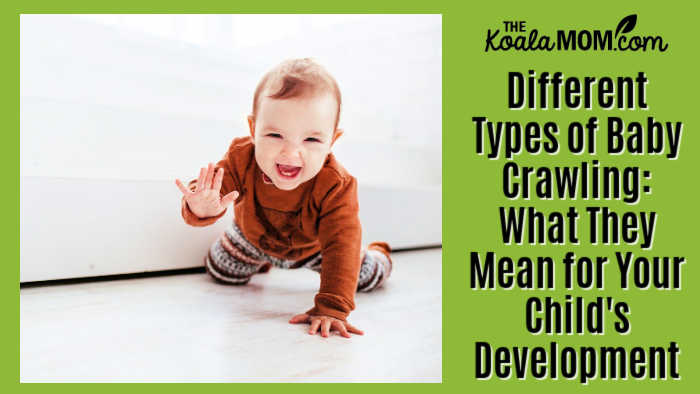Crawling is a significant milestone in a baby’s development, marking their growing mobility and exploration of the world around them. It’s not just a way for babies to move; it plays a vital role in strengthening their muscles, improving coordination, and developing spatial awareness.
Interestingly, babies may adopt different types of crawling, from the traditional hands-and-knees crawl to the less common bear crawl. Understanding these types of crawling can help parents and caregivers identify their baby’s progress and ensure that they are developing essential motor skills. This article will explore the various crawling types and what they might indicate about your child’s physical development.

The Classic Hands-and-Knees Crawl
The most recognized form of crawling is the hands-and-knees crawl, also known as the traditional crawl. In this method, babies support their body weight on their hands and knees, moving one hand and the opposite knee forward in a coordinated, rhythmic pattern. This type of crawling requires a considerable amount of strength, coordination, and balance, as babies must stabilize themselves while propelling forward.
The hands-and-knees crawl is often viewed as a positive indicator of motor skill development. Research indicates that babies who engage in this crawling style typically develop better hand-eye coordination, as the movement involves bilateral coordination (using both sides of the body simultaneously). A study published in the Journal of Physical Therapy Science found that babies who used the traditional crawl showed improved muscle tone and strength, particularly in the arms, legs, and core, setting a strong foundation for future motor milestones like walking and running.
Pssst… once baby starts trying to crawl and move around, it’s time to install baby safety gates!
The Commando Crawl: Building Upper Body Strength
The commando crawl, also known as the army crawl, is another common crawling style where babies move forward using their elbows and forearms while their stomach remains on the ground. This type of crawling closely resembles a soldier’s low crawl and is often observed in the early stages of mobility when babies are still developing the strength to lift their torso off the floor.
While some parents may worry that the commando crawl indicates a delay in motor development, it can actually be a positive sign of upper body strength. Babies who commando crawl are building muscle in their shoulders, arms, and chest, which is crucial for future skills like pulling up and climbing. The Australian Association of Pediatric Physiotherapy suggests that the commando crawl helps babies develop spatial awareness and strengthen their core muscles, which are essential for transitioning to more advanced crawling styles.
My children started out with commando crawling, in their first attempts to move themselves forwards. Very soon, this progressed into the classic hands-and-knees crawl, which they all preferred. It was fun to watch and cheer their various efforts to move themselves forwards and to see what they learned.
The Bear Crawl: Enhancing Balance and Coordination
The bear crawl is a unique crawling style where babies lift their knees off the ground, moving on their hands and feet instead. In this position, the baby resembles a bear, hence the name. This type of crawling requires a higher level of strength, balance, and coordination than the traditional hands-and-knees crawl, as it involves supporting more body weight on the arms and legs.
The bear crawl can be an excellent indicator of a baby’s developing motor skills and physical capabilities. Pediatricians note that bear crawling helps enhance balance and proprioception, the body’s ability to sense its position in space. A study in the International Journal of Pediatrics found that babies who bear crawl demonstrate improved gross motor development, which can lead to more confident walking and running as they grow older. If your baby adopts this crawling style, it’s a positive sign that they are developing strong muscles and coordination.
The Crab Crawl: Unusual Yet Normal
The crab crawl is less common and is characterized by a sideways movement, where babies push off with one hand and leg while dragging the other side of their body. This results in a sideways, often asymmetrical crawl, resembling the movement of a crab. While this type of crawling may look unusual, it is generally a normal variation and not necessarily a cause for concern.
Crab crawling can indicate that a baby is experimenting with different ways of moving and may be adapting to their unique physical strengths and preferences. However, if the crab crawl persists for an extended period or is accompanied by difficulty using both sides of the body, it might warrant further evaluation by a pediatrician. A study by the American Academy of Pediatrics found that around 10% of babies exhibit asymmetrical crawling patterns, such as crab crawling, which usually resolves as they gain more motor skills.
The Rolling Crawl: Exploring Alternative Movement
Some babies skip traditional crawling altogether and prefer to get around by rolling. The rolling crawl involves babies propelling themselves forward by rolling from side to side, using their whole body to change direction and explore their surroundings. While this may not be classified as a typical ‘crawl,’ it serves as an alternative method of movement and exploration.
Pediatric therapists suggest that rolling can help develop a baby’s spatial awareness and coordination. However, they also recommend encouraging other forms of movement, such as reaching and pushing up, to help build upper body strength and support the transition to more advanced motor skills. A study in the Child Development Journal notes that while rolling is a common phase in early mobility, most babies eventually transition to more traditional types of crawling as they gain strength and coordination.
The Bottom Scoot: A Unique Crawling Variation
The bottom scoot, also known as bum shuffling, is another alternative crawling style where babies move around in a seated position, using their arms to push and their legs to propel themselves forward. While this type of crawling is relatively rare, it is a normal variation in motor development. Babies who prefer the bottom scoot often have strong trunk muscles and may be more inclined to pull up and cruise on furniture.
Parents may worry that bottom scooting indicates a delay in traditional crawling; however, many babies who scoot still develop strong motor skills and transition to walking without any issues. According to a study published in the Journal of Developmental Medicine & Child Neurology, about 5% of babies adopt the bottom scoot as their primary means of mobility. This variation highlights that there is no single ‘correct’ way for babies to move; each child develops at their own pace.
The Implications of Crawling Styles for Future Development
The different types of crawling are more than just methods of movement; they provide insights into a baby’s motor development and physical abilities. Crawling helps babies develop strength, coordination, and sensory processing skills, which are essential for future milestones like walking, running, and climbing. Each crawling style—whether it’s the traditional hands-and-knees, commando, bear, crab, rolling, or bottom scoot—contributes uniquely to a child’s growth.
It’s important for parents to observe their baby’s crawling patterns and provide encouragement and a safe environment for exploration. However, there is no need for concern if a baby adopts an unconventional crawling style, as variations are normal. If there are concerns about a child’s development or if they are not attempting any form of crawling by 12 months, consulting a pediatrician for guidance is recommended.

Crawling is a vital developmental milestone that marks a baby’s growing independence and physical capabilities. The various types of crawling, from the traditional hands-and-knees crawl to the more unique bottom scoot, each play a role in developing strength, coordination, and spatial awareness. Understanding these crawling styles can help parents and caregivers support their child’s progress and recognize that every baby develops at their own pace

No Responses Yet